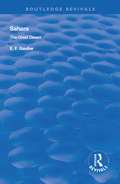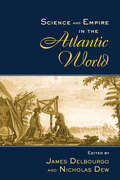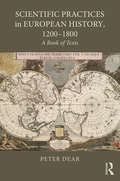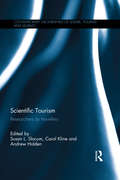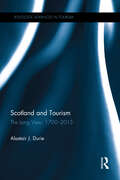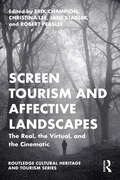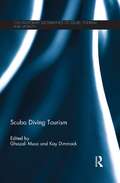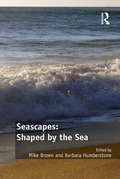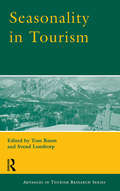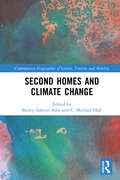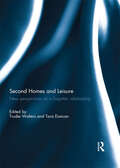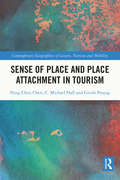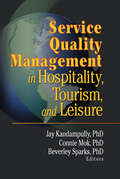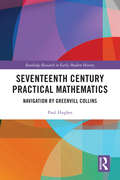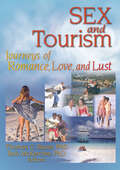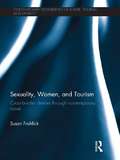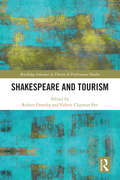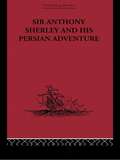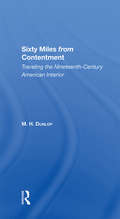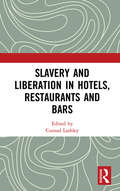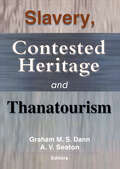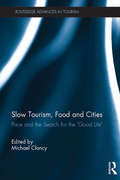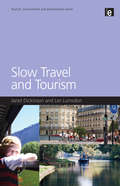- Table View
- List View
Sahara: The Great Desert (Routledge Revivals)
by E. F. GautierThis book was originally published in 1935. The Sahara, or as it is otherwise known, the Great Desert, is probably the most outstanding desert on the surface of the earth - not only because of its exceptional aridity, but by reason of its tremendous size as well. This book examines the Sahara, including chapters on the structural formation, the climate, the geological past, and the different regions of the Sahara.
Science and Empire in the Atlantic World (New Directions in American History)
by Nicholas Dew James DelbourgoScience and Empire in the Atlantic World is the first book in the growing field of Atlantic Studies to examine the production of scientific knowledge in the Atlantic world from a comparative and international perspective. Rather than focusing on a specific scientific field or single national context, this collection captures the multiplicity of practices, people, languages, and agendas that characterized the traffic in knowledge around the Atlantic world, linking this knowledge to the social processes fundamental to colonialism, such as travel, trade, ethnography, and slavery.
Science of Food: An Introduction To Food Science, Nutrition And Microbiology
by K. B. Sherrington P. M. GamanFirst Published in 1998. Routledge is an imprint of Taylor & Francis, an informa company.
Scientific Practices in European History, 1200-1800: A Book of Texts
by Peter DearScientific Practices in European History, 1200–1800 presents and situates a collection of extracts from both widely known texts by such figures as Copernicus, Newton, and Lavoisier, and lesser known but significant items, all chosen to provide a perspective on topics in social, cultural and intellectual history and to illuminate the concerns of the early modern period. The selection of extracts highlights the emerging technical preoccupations of this period, while the accompanying introductions and annotations make these occasionally complex works accessible to students and non-specialists. The book follows a largely chronological sequence and helps to locate scientific ideas and practices within broader European history. The primary source materials in this collection stand alone as texts in themselves, but in illustrating the scientific components of early modern societies they also make this book ideal for teachers and students of European history.
Scientific Tourism: Researchers as Travellers (Contemporary Geographies of Leisure, Tourism and Mobility)
by Carol Kline Andrew Holden Susan SlocumAs researchers in emerging economies, scientists are often the first foreign visitors to stay in remote rural areas and, on occasion, form joint venture ecotourism and community tourism projects or poverty alleviation schemes between local agencies or NGOs, the local community, and their home institution or agency. They therefore can contribute to avenues for the conservation of natural resources and the development of rural communities as well as influencing the future tourism development through its perceived legitimacy and the destination image it promotes. <P><P> This book for the first time critically reviews tourism debates surrounding this emerging market of scientific and research oriented tourism. It is divided into three inter-related sections. Section 1 sets the stage of the discourse of scientific research in tourism; Section 2 evaluates the key players of scientific tourism looking particularly at the roles of NGOs, government agencies and university academic staff and Section 3 contains case studies documenting the niche of researchers as travelers in a range of geographical locations including Tanzania, Australia, Chile, Peru and Mexico. The title’s multidisciplinary approach provides an informed, interesting and stimulating addition to the existing limited literature and raises many issues and associated questions including the role of science tourism in tourism development and expansion, the impacts of scientific and research-based tourism, travel behaviors and motivations of researchers to name but a few. <P><P> This significant volume will provide the reader with a better understanding of scientists as travelers, their relationship to the tourism industry, and the role they play in community development around tourism sites. It will be valuable reading for students and academics across the fields of Tourism, Geography and Development Studies as well as other social science disciplines.
Scotland and Tourism: The Long View, 1700–2015 (Routledge Advances in Tourism)
by Alastair J. DurieTourism has long been important to Scotland. It has become all the more significant as the financial sector has faltered and other mainstays are in apparent long-term decline. Yet there is no assessment of this industry and its place over the long run, no one account of what it has meant to previous generations and continues to mean to the present one, of what led to growth or what indeed has led people of late to look elsewhere. This book brings together work from many periods and perspectives. It draws on a wide range of source material, academic and non-academic, from local studies and general analyses, visitors’ accounts, hotel records, newspaper and journal commentaries, photographs and even cartoons. It reviews arguments over the cultural and economic impact of tourism, and retrieves the experience of the visited, of the host communities as well as the visitors. It questions some of the orthodoxies – that Scott made Scott-land, or that it was charter air flights that pulled the rug from under the mass market – and sheds light on what in the Scottish package appealed, and what did not, and to whom; how provision changed, or failed to change; and what marketing strategies may have achieved. It charts changes in accommodation, from inn to hotel, holiday camp, caravanning and timeshare. The role of transport is a central feature: that of the steamship and the railway in opening up Scotland, and later of motor transport in reshaping patterns of holidaymaking. Throughout there is an emphasis on the comparative: asking what was distinctive about the forms and nature of tourism in Scotland as against competing destinations elsewhere in the UK and Europe. It concludes by reflecting on whether Scotland's past can inform the making and shaping of tourism policy and what cautions history might offer for the future. This prolific long-term analysis of tourism in Scotland is a must-read for all those interested in tourism history.
Screen Tourism and Affective Landscapes: The Real, the Virtual, and the Cinematic (Routledge Cultural Heritage and Tourism Series)
by Erik Champion Christina Lee Jane Stadler Robert Moses PeasleeThis book explores ways in which screen-based storyworlds transfix, transform, and transport us imaginatively, physically, and virtually to the places they depict or film. Topics include fantasy quests in computer games, celebrity walking tours, dark tourism sites, Hobbiton as theme park, surf movies, and social gangs of Disneyland. How physical, virtual, and imagined locations create a sense of place through their immediate experience or visitation is undergoing a revolution in technology, travel modes, and tourism behaviour. This edited collection explores the rapidly evolving field of screen tourism and the affective impact of landscape, with provocative questions and investigations of social groups, fan culture, new technology, and the wider changing trends in screen tourism. We provide critical examples of affective landscapes across a wide range of mediums (from the big screen to the small screen) and locations. This book will appeal to students and scholars in film and tourism, as well as geography, design, media and communication studies, game studies, and digital humanities.
Scuba Diving Tourism (Contemporary Geographies of Leisure, Tourism and Mobility #40)
by Ghazali Musa Kay DimmockThis volume offers new insight into an important and largely under-examined area of marine leisure and tourism: scuba diving tourism. Knowledge of scuba diving has long been hidden among broad discussions of water-based sports and activities and this focused book aims to shed further understanding and knowledge on this popular international activity. The book examines the current issues central to research into and management of scuba diving Tourism from multidisciplinary perspectives such as health and safety, climate change, policy and regulation and the recreation/leisure context. It further reveals critical management issues of economic, environmental and socio-cultural impacts related to scuba diving tourism which extends to the influence of climate change on the industry’s operations and future. This significant volume which conceptualizes the issues surrounding scuba diving tourism now and in the future is written by leading experts in this field and will be valuable reading for all those interested in marine leisure and tourism.
Seascapes: Shaped By The Sea
by Mike Brown Barbara HumberstoneDespite the fact that the sea covers 70 per cent of the Earth’s surface, and is integral to the workings of the world, it has been largely neglected or perceived as marginal in modern consciousness. This edited collection disrupts notions of the sea as ’other’, as foreign and featureless, through specific, situated accounts which highlight the centrality of the sea for the individuals concerned. Bringing together academics who combine scholarly expertise with lived experiences on, in and with the sea, it examines humans’ relationships with the sea. Through the use of auto-ethnographic accounting, the contributors reflect on how the sea has shaped their sense of identity, belonging and connection. They examine what it is to be engaged with the sea, and narrate their lived, sentient, corporeal experiences. The sea is a cultural seascape just as it is physical reality. The sea shapes us and we, in turn, attempt to ’shape it’ as we construct various versions of it that reflect our on-going and mutable relationship with it. The use of embodied accounts, as a way of conveying lived-experiences, and the integration of relevant theoretical frames for understanding the broader cultural implications provide new opportunities to understand seascapes.
Seasonality in Tourism (Advances In Tourism Research Ser.)
by Tom Baum Svend LundtropSeasonal variation in demand is a reality for most tourism destinations. This work provides a balanced overview of the evidence and issues relating to tourism seasonality using European, North American and Pacific Rim cases and research evidence.
Second Homes and Climate Change (Contemporary Geographies of Leisure, Tourism and Mobility)
by C. Michael Hall Bailey Ashton AdieThis book is the first to address the important interrelationship between second homes and climate change, which has become an increasingly relevant issue for many regions around the world. Second homes are often a key source of tourist visitation as well as economic benefit for their host communities. The chapters provide an array of international case studies and climate change impacts, including the changing biocultural landscapes in Italy, hazard risks in the mountains of Poland, and the shifting media discussion on second homes and climate change in Finland. Topics covered focus on issues around planning and governance in second home locations, adaptation and mitigation measures implemented by second home owners, and the influence of second home owners’ place attachment in relation to second home impacts. It introduces the overall topic of second homes and climate change while also laying the groundwork for future work in this burgeoning area of research. This book will be of significant interest to upper-level undergraduates, graduate students, and academics in the fields of geography, tourism, planning, housing studies, regional development, environmental management, and disaster management. It would also be of use for professionals who engage with second home communities, particularly planners, government officials, and environmental officers.
Second Homes and Leisure: New perspectives on a forgotten relationship
by Trudie Walters and Tara DuncanSecond homes (variously summer houses, shacks, baches, cottages, dacha) are a popular cultural phenomenon in many countries and an emerging trend in others. They are inextricably linked to tourism, recreation and leisure, and yet the fundamental relationship between second homes and leisure often appears to have been overlooked by researchers in the area. This book seeks to address this absence, bringing together an exciting collection of research from around the world. Drawing on examples from Canada, Japan, Morocco, Costa Rica, New Zealand and the United Kingdom, this book highlights the interdisciplinary nature of second home research in the leisure field. The book describes the nexus of second homes and leisure from a variety of perspectives: planning and policy, historical, social and cultural. It is an essential work for those interested in new cultural viewpoints on second homes and leisure practices. This book was originally published as a special issue of Annals of Leisure Research.
Segmentation Strategies for Hospitality Managers: Target Marketing for Competitive Advantage
by Art Weinstein Ron MorrittGet the competitive edge in a fierce market!Effective market segmentation approaches can show a company which customer group is most profitable and how to best serve their needs. Segmentation Strategies for Hospitality Managers: Target Marketing for Competitive Advantage is a marketing primer whose time has come, teaching segmentation approaches that can make a difference where it really counts-the bottom line. Introductory to intermediate level hospitality managers and students are provided with easy-to-follow explanations and effective learning exercises that will help them grasp segmentation concepts and strategies quickly. Unlike other hospitality marketing textbooks out there, this book persistently focuses specifically on segmentation and positioning strategies.Segmentation Strategies for Hospitality Managers effectively tells how to best use the integrated resources of a hospitality firm to gain and maintain the competitive edge. Examples are taken from the hotel, restaurant, and airline industries to give a well-rounded view of the industry&’s practical and productive use of segmentation strategies. The text explains advantages and limitations of various segmentation strategies such as relationship or niche marketing to help assist managers in their own future decision-making process. Detailed chapter summaries and challenging end-of-chapter exercises further reinforce each chapter&’s concepts and approaches. Extensive references, several illustrative figures and tables, and specific case examples from various hospitality sectors are included.Topics in Segmentation Strategies for Hospitality Managers include: positioning strategy niche marketing relationship marketing marketing trends technology&’s impact on the hospitality industryspecial issues in segmentation strategy (including integration of segmentation strategy with branding, yield management, and IT strategy) and more!Segmentation Strategies for Hospitality Managers is a resource certain to be used again and again and is perfect for hospitality managers, marketing and hospitality educators, hospitality and travel and tourism students, and business school students world wide.
Sense of Place and Place Attachment in Tourism (Contemporary Geographies of Leisure, Tourism and Mobility)
by C. Michael Hall Girish Prayag Ning Chris ChenPlace is integral to tourism. In tourism, almost all issues can ultimately be traced back to human–place interactions and human–place relationships. Sense of place, also referred to as place attachment, topophilia, and community sentiment, has received significant attention in tourism studies because it both contributes to, and is affected by, tourism. This book, written by notable authors in the field, examines sense of place and place attachment in terms of a typology of sense of place/place attachment that includes genealogical/historical, narrative/cultural, economic, ideological, cosmological, and dynamic elements. Dimensions of place attachment such as place identity, place dependence, and affective attachment are discussed as well as place marketing, place making, and destination management. Complete with a range of illustrative international cases and examples ranging from Santa Claus to the importance of place in indigenous and traditional cultures, this book represents a substantial addition to knowledge on the inseparable relationship between tourism and place and will be of great interest to all upper-level students and researchers of Tourism.
Service Quality Management in Hospitality, Tourism, and Leisure
by Beverley Sparks Connie Mok Jay KadampullyDoes your staff deliver the highest quality service possible?Customers today expect a very high overall level of service in hospitality, tourism, and leisure. Competition in these fields will thus be driven by strategies focusing on quality of service to add value, as opposed to product or price differentiation. Service Quality Management in Hospitality, Tourism, and Leisure highlights concepts and strategies that will improve the delivery of hospitality services, and provides clear and simple explanations of theoretical concepts as well as their practical applications! Practitioners and educators alike will find this book to be invaluable in their businesses and in preparing students for the business world.This essential book provides you with clear, comprehensive explanations of theoretical concepts and methods that will give you the competitive edge in this fast-changing field. Topics covered include: services management marketing operations management human resources management service quality management Service Quality Management in Hospitality, Tourism, and Leisure brings together an array of pertinent materials that will measure and enhance customer satisfaction and help you provide superior hospitality services, and groups them in easy-to-use clusters for quick reference.
Seventeenth Century Practical Mathematics: Navigation by Greenvill Collins
by Paul HughesThis exciting Greenvill Collins biography is about seventeenth century navigation, focusing for the first time on mathematics practised at sea. This monograph argues the Restoration kings’, Charles II and James II, promotion of cartography for both strategy and trade. It is aimed at the academic, cartographic and larger market of marine enthusiasts. Through shipwreck and Arctic marooning, and Dutch and Spanish charts, Collins evolved a Prime Meridian running through Charles’s capital. After John Ogilby’s successful Britannia, Charles set Collins surveying his kingdom’s coasts, and James set John Adair surveying in Scotland. They triangulated at sea. Subsequently, Collins persuaded James to sustain his dead brother’s ambition. This, the British coast’s first survey took six years. After James’s flight, and William III’s invasion, Collins lead the royal yacht squadron for six years more, garnering funds to publish Great Britain’s Coasting Pilot. The Admiralty and civic institutions subsidised what became his own pilot. Collins aided Royal Society members in their investigations, and his new guide remained vital to navigators through the century following. Charles’s cartographic promotion bloomed the most spectacularly in the atlases of Ogilby, Collins and John Flamsteed for roads, harbours, and stars.
Sex and Tourism: Journeys of Romance, Love, and Lust
by Thomas Bauer Bob Mckercher Kaye Sung ChonExplore the complex relationship between tourism and intimacy in this new book with a worldwide perspective! With a unique combination of academic and personal accounts, Sex and Tourism: Journeys of Romance, Love, and Lust takes you behind the scenes with motel owners, adventure travel guides, backpackers, and others working on all sides of the international tourism industry. The editors have created a model that views the situation from three different perspectives: tourist, tourism provider, and nature of the encounter. Unlike other related volumes, this book is not just about the sex trade, but also about the role of tourism in love, marriage, and relationships. The global focus of Sex and Tourism will introduce you to: off-season romance on the island of Crete sex tourism in Cambodia a South Korean museum dedicated to women forced into sexual slavery by the Japanese military the sexual aspects of adventure travel in Canada cross-cultural marriage in Thailand gentleman's clubs in New Orleans Australian river guides and their potential liaisons with clients People who travel to escape their day-to-day lives often become involved in situations they would never find themselves in at home. Good or bad, many of these situations are examined in Sex and Tourism. You'll learn about the illegal trafficking of girls in Nepal, worldwide programs for combating child sex rings, and the lethal combination of AIDS and tourism, but you'll also find accounts of love and romance far from home. You will see how the tourism industry can act as a facilitator of human intimacy and what happens when different cultural realities collide. Anyone involved in recreation, leisure, anthropology, social science, or tourism will be interested in this book. Sex and Tourism is an enlightening guide to the complex world found at the crossroads of sightseeing and sex.
Sexuality, Women, and Tourism: Cross-Border Desires through Contemporary Travel (Contemporary Geographies of Leisure, Tourism and Mobility #35)
by Susan FrohlickThis book is the first to focus on why and how foreign Western women engage in cross-border sexual and intimate relations as tourists travelling, or temporarily dwelling, in a Central American country. As an in-depth ethnographic account, the book traces the experiences of heterosexual North American and European women’s transnational encounters, and examines new sexual and social practices arising from contemporary global tourism, shifting sexual cultures both at home and abroad, consumer culture, and women’s increasing mobility. The book combines descriptions of women’s travels and sexual relations across racial and class boundaries with feminism, postcolonial theory, and poststructuralist theories of gender and sexuality, to show how tourism as a wide range and set of desires serves as a central shaping force in the formation of women’s sexual subjectivities in contemporary life in postindustrial capitalism. In doing so it offers new insights into how tourist women express heterosexuality shaped by gender, race, class, and identities. This fascinating book, focusing on the structure of tourism and role of local culture and social organization in the shoring-up of desire, develops a unique contribution to the understanding of sex tourism. It will be of interest not only to tourism scholars, but also to those interested in sexuality, anthropology, sociology, cultural studies, women studies, gender studies, and geography.
Shakespeare and Tourism (Routledge Advances in Theatre & Performance Studies)
by Valerie Clayman Pye Robert OrmsbyShakespeare and Tourism provides a dialogical mapping of Shakespeare studies and touristic theory through a collection of essays by scholars on a wide range of material. This volume examines how Shakespeare tourism has evolved since its inception, and how the phenomenon has been influenced and redefined by performance studies, the prevalence of the World Wide Web, developments in technology, and the globalization of Shakespearean performance. Current scholarship recognizes Shakespearean tourism as a thriving international industry, the result of centuries of efforts to attribute meanings associated with the playwright’s biography and literary prestige to sites for artistic pilgrimage and the consumption of cultural heritage. Through bringing Shakespeare and tourism studies into more explicit contact, this collection provides readers with a broad base for comparisons across time and location, and thereby encourages a thorough reconsideration of how we understand both fields.
Sir Anthony Sherley and his Persian Adventure
by Anthony SherleyAs well as including Sherley's own account of his journey into Persia in 1600, this valuable edition includes the main works dealing with Anthony Sherley and his life. Original inaccessible texts are reprinted in full and the critical bibliographical introduction provides excellent guidance for the understanding of the various sources (and their merits and limitations), and the context in which Sherley's own account was composed.When first published in 1933, Sherley's narrative (1613) had never before been reprinted.
Sixty Miles From Contentment: Traveling The Nineteenth-Century American Interior
by M. H. DunlopSixty Miles from Contentment is a revitalization of a pulsating American scene in the nineteenth-century. Drawing on the work of travel writers from America's own East Coast and from fourteen other countries, it offers a witty and irreverent look at the wild Midwest in its heyday.
Slavery and Liberation in Hotels, Restaurants and Bars
by Conrad LashleyThis is the first book to explore workforce slavery and liberation together within commercial hotel, restaurant and bar activities, the hospitality industry being particularly vulnerable to potential illegal action and reputational damage via involuntary involvement in human trafficking and sexual exploitation. Slavery is the most oppressive form of labour exploitation and is illegal in Western Europe and most of the industrialised world. On the other hand, ‘neo-slavery’ oppresses the powerless through low pay and employment practices that predominantly serve the interests of the employer. This book explores the most exploitative forms of slavery, 'neo-slavery' and human trafficking in the hotel industry, and offers insights into empowerment through liberative trade unions and worker co-operatives. The study’s multifaceted cross-cultural approach includes in-depth chapters on Brazil and the Netherlands as well as a multitude of examples from the UK, exposing the topic as an international problem. Written by international specialists, this significant book will appeal widely to upper-level students and researchers in hospitality, and specifically, to all those interested in human resource management in the hospitality and hotel industry, as well as human rights issues and business ethics.
Slavery, Contested Heritage, and Thanatourism (Journal Of Hospitality And Tourism Administration Ser. #Vol. 2, Nos. 3-4)
by Graham M.S. Dann A.V. SeatonFirst published in 2002. Routledge is an imprint of Taylor & Francis, an informa company.
Slow Tourism, Food and Cities: Pace and the Search for the "Good Life" (Routledge Advances in Tourism)
by Michael ClancySlow Food began in the late 1980s as a response to the spread of fast food establishments and as a larger statement against globalization and the perceived deterioration of modern life. Since then, slow practices have permeated into other areas, including cities and territories and travel and tourism. This book provides an in-depth examination of slow food, tourism and cities, demonstrating how these elements are intertwined with one other as part of the modern search for "the good life." Part 1 locates the slow concept within the larger social setting of modernity and investigates claims made by the slow movement, examining aesthetic and instrumental values inherent to it. Part 2 explores the practices and places of slow, containing both conceptual and empirical chapters in Italy, the birthplace of the movement. Part 3 provides a comparative perspective by examining the practices in Spain, the UK, Germany and Canada. Slow Tourism, Food and Cities offers key theoretical insights and alternative perspectives on the varying practices and meanings of slow from a cultural, sociological and ethical perspective. It is a valuable text for students and scholars of sociology, geography, urban studies, social movements, travel and tourism, and food studies.
Slow Travel and Tourism (Tourism, Environment And Development Ser.)
by Janet Dickinson Les LumsdonIt is widely recognized that travel and tourism can have a high environmental impact and make a major contribution to climate change. It is therefore vital that ways to reduce these impacts are developed and implemented. 'Slow travel' provides such a concept, drawing on ideas from the 'slow food' movement with a concern for locality, ecology and quality of life. The aim of this book is to define slow travel and to discuss how some underlining values are likely to pervade new forms of sustainable development. It also aims to provide insights into the travel experience; these are explored in several chapters which bring new knowledge about sustainable transport tourism from across the world. In order to do this the book explores the concept of slow travel and sets out its core ingredients, comparing it with related frameworks such as low-carbon tourism and sustainable tourism development. The authors explain slow travel as holiday travel where air and car transport is rejected in favour of more environmentally benign forms of overland transport, which generally take much longer and become incorporated as part of the holiday experience. The book critically examines the key trends in tourism transport and recent climate change debates, setting out the main issues facing tourism planners. It reviews the potential for new consumption patterns, as well as current business models that facilitate hyper-mobility. This provides a cutting edge critique of the 'upstream' drivers to unsustainable tourism. Finally, the authors illustrate their approach through a series of case studies from around the world, featuring travel by train, bus, cycling and walking. Examples are drawn from Europe, Asia, Australia and the Americas. Cases include the Eurostar train (as an alternative to air travel), walking in the Appalachian Trail (US), the Euro-Velo network of long-distance cycling routes, canoe tours on the Gudena River in Denmark, sea kayaking in British Columbia (Canada) and the Oz Bus Europe to Australia.
